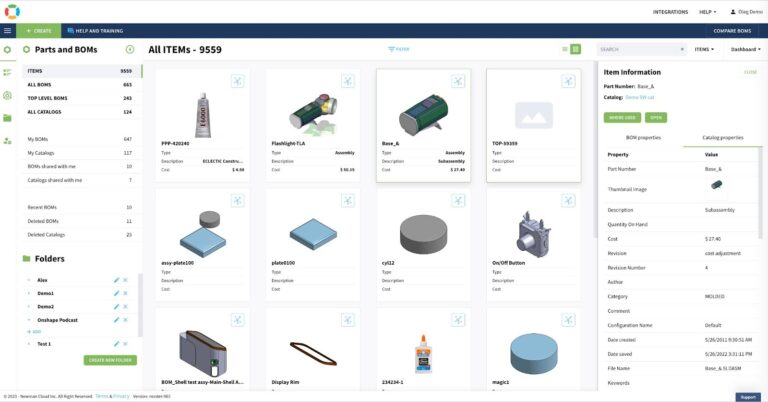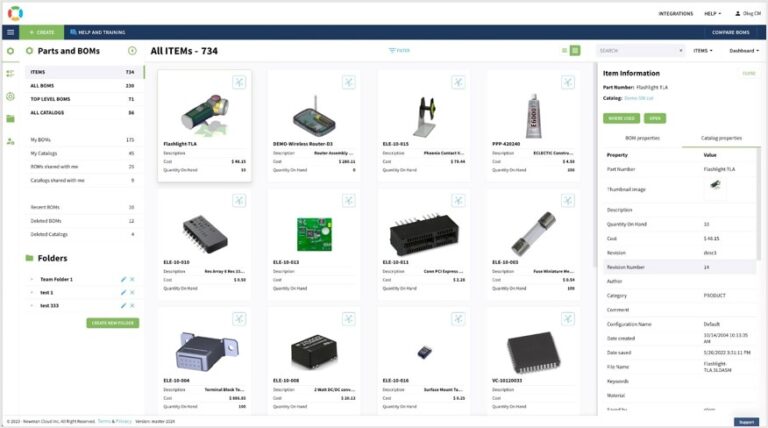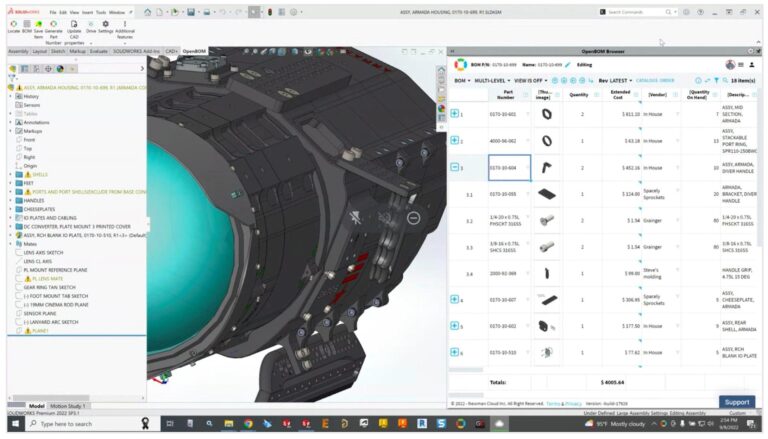OpenBOM™ is a registered Trademark of Newman Cloud, Inc. | © 2022
- Home
- Training Courses
- OpenBOM Basics Course
- Registration & Settings
- Dashboard Walkthrough & Searches
- Creating BOMs from Excel
- Creating BOMs from CAD
- Creating BOMs Manually
- Preparing Catalogs
- Multi-Level & Flattened BOMs
- Exporting Reports
- Creating User-Defined Views & Filtering Information
- Real-Time Collaboration
- Revision & Change Management
- Managing Your Team
- OpenBOM Data Management Course
- OpenBOM Change Management Course
- End-to-End Design to Purchase Process
- Introduction
- 1. Install OpenBOM Add-In
- 2. Sign into OpenBOM
- 3. Edit Your Settings
- 4. Create a BOM Using the One-Click BOM
- 5. Create a Vendor List
- 6. Open Your CAD Items Catalog
- 7. Add Business Data to Your Items (Vendors and Costs)
- 8. Order Long-Lead Items
- 9. Mark a Purchase Order as “Received” in OpenBOM
- 10. Create an Order BOM
- 11. Create a Purchase Order
- 12. Export a Purchase Order
- OpenBOM CAD Integration Courses
- OpenBOM Design Course
- Premium Onboarding Experience
- OpenBOM Basics Course
- Getting Started
- Video Demos
- OpenBOM Basics
- Training Courses
- Part Number Management
- Import Data
- Design Projects
- New Product Development Process
- CAD Integrations
- Bill of Materials
- OpenBOM Community
- “Where Used” and Graph Navigation
- Flattened BOM Feature
- Generate PDFs (and More) from CAD
- Generate Part Numbers for CAD
- Create RFQs and POs
- Manage Revisions of Attached Files
- Export Data as a Zip
- OpenBOM YouTube Channel
- Administration
- Data Management
- Properties
- File Management
- Search & Filters
- BOM Types
- Creating BOMs
- BOM Compare Service
- Formulas, Calculations, & Rollups
- Organizing Data
- Custom Objects
- Design Projects
- Using Templates
- Exporting Data
- User-Defined Views
- Team Views
- Collaborate & Share
- Production Planning & Inventory Control
- Change Management and Revision Control
- User Defined Commands
- xBOM Types
- Integrations
- Home
- Training Courses
- OpenBOM Basics Course
- Registration & Settings
- Dashboard Walkthrough & Searches
- Creating BOMs from Excel
- Creating BOMs from CAD
- Creating BOMs Manually
- Preparing Catalogs
- Multi-Level & Flattened BOMs
- Exporting Reports
- Creating User-Defined Views & Filtering Information
- Real-Time Collaboration
- Revision & Change Management
- Managing Your Team
- OpenBOM Data Management Course
- OpenBOM Change Management Course
- End-to-End Design to Purchase Process
- Introduction
- 1. Install OpenBOM Add-In
- 2. Sign into OpenBOM
- 3. Edit Your Settings
- 4. Create a BOM Using the One-Click BOM
- 5. Create a Vendor List
- 6. Open Your CAD Items Catalog
- 7. Add Business Data to Your Items (Vendors and Costs)
- 8. Order Long-Lead Items
- 9. Mark a Purchase Order as "Received" in OpenBOM
- 10. Create an Order BOM
- 11. Create a Purchase Order
- 12. Export a Purchase Order
- OpenBOM CAD Integration Courses
- OpenBOM Design Course
- Premium Onboarding Experience
- OpenBOM Basics Course
- Getting Started
- Video Demos
- OpenBOM Basics
- Training Courses
- Part Number Management
- Import Data
- Design Projects
- New Product Development Process
- CAD Integrations
- Bill of Materials
- OpenBOM Community
- "Where Used" and Graph Navigation
- Flattened BOM Feature
- Generate PDFs (and More) from CAD
- Generate Part Numbers for CAD
- Create RFQs and POs
- Manage Revisions of Attached Files
- Export Data as a Zip
- OpenBOM YouTube Channel
- Administration
- Data Management
- Properties
- File Management
- Search & Filters
- BOM Types
- Creating BOMs
- BOM Compare Service
- Formulas, Calculations, & Rollups
- Organizing Data
- Custom Objects
- Design Projects
- Using Templates
- Exporting Data
- User-Defined Views
- Team Views
- Collaborate & Share
- Production Planning & Inventory Control
- Change Management and Revision Control
- User Defined Commands
- xBOM Types
- Integrations
OpenBOM Basics
Learn the basics of OpenBOM by understanding what it is, how it works, and what it does.
OpenBOM Overview
What Is OpenBOM?
OpenBOM is an online platform designed to manage product data, manage processes, and facilitate the sharing of information among manufacturers, contractors, and suppliers. OpenBOM helps organize siloed information and connect engineers, manufacturers, and supply chains.
It delivers cloud-based, real-time collaboration, enabling teams to create and manage product structures (bill of materials – BOMs), inventories, and other related data.
The vision of OpenBOM is to organize and connect information, streamline communication, and eliminate the need to use various unstructured data sources such as different spreadsheets and documents.
What’s the OpenBOM Platform Like?
OpenBOM is an online platform that requires an account and password for access. Similar to global online platforms like Google, Microsoft Office 365, Autodesk, PTC Onshape, and others, users can access information through a browser or integrated tools.
Each user has a login associated with a company account. The company admin can define access levels, ranging from broad access to specific attributes (such as cost or engineering files) or objects (such as a bill of material or catalog).
Upon logging in to OpenBOM in the browser, users are presented with multiple dashboards for different types of information, including design, parts and bill of materials (BOMs), production planning, and change management, and soon users will also see custom objects.
OpenBOM Data Management
OpenBOM provides a flexible and configurable data model allowing customers to manage the data of the products they need and support processes in their organizations such as design, engineering, production, procurement, and supply chain.
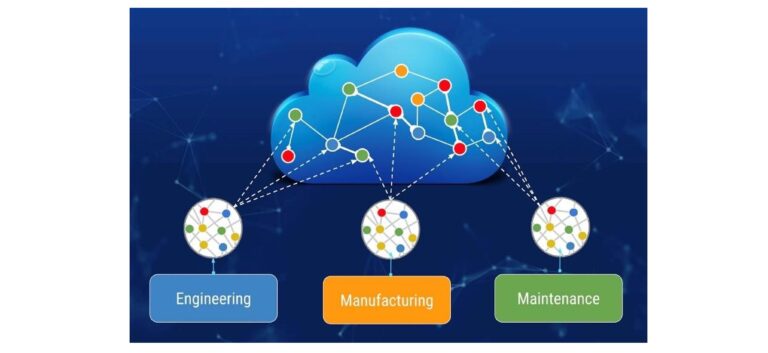
Multi-Tenant Capabilities
OpenBOM facilitates multi-tenant capabilities. The foundation of OpenBOM data management is a graph-based multi-tenant data model allowing the creation of objects and relationships. Flexible object definition and structure allow for the management of various characteristics (properties) which can be connected.
By providing a flexible configurable data model, OpenBOM helps connect different product lifecycle stages and companies to operate together in a connected way.
The core data elements of OpenBOM are configurable object types and product data models, allowing us to define items (e.g. parts or sssemblies) or other types of data and different types of product structures (xBOM).
Main OpenBOM Object Types
OpenBOM provides out-of-the-box data objects with flexible and fully customizable data properties as well as the creation of custom object types.
These are the primary predefined object types in OpenBOM that you will see in your account after registration:
Design (Design Projects, Folders and Files)
These are objects to represent the design data (e.g. CAD files or design objects stored in cloud CAD systems). OpenBOM allows managing design data using multiple services such as Design Projects, also storing files on a collaborative disk (Drive) or connecting directly to a cloud CAD service. OpenBOM settings and CAD integrations allow you to connect to different design data structures to manage them or to extract data from online CAD services.
Items (Catalogs)
This is an object that represents the foundation of the product data model. Every element of the product can be defined as an item (e.g. a screw, resistor, chip, assembly, or an entire product). By defining multiple catalogs, OpenBOM allows you to create a classification of items, as each type (catalog) has a specific set of attributes.
Product Structure (xBOM)
A BOM is a data structure that represents relationships between items and facilitates the storage and management of product structures. This is from a technical perspective represented as DAG (direct acyclic graph), which is known to everyone as a multi-level Bill of Materials.
Planning or Order (BOM)
This model enables production planning and involves a separate BOM (planning or MBOM) that scales a product BOM for multiple production units. It helps calculate purchasing gaps based on inventory levels and facilitates the selection of vendors to create RFQs and Purchase Orders (POs).
Vendors
This is a set of objects to manage contractors and suppliers. It includes all information about suppliers and can be used for “sourcing” functions in catalogs to define multiple suppliers to purchase services or components from.
Custom Object
This Custom Object feature allows to extend OpenBOM data model with new data types as well as to build links between them. While out-of-the-box object models provide a rich set of modeling capabilities, OpenBOM is bringing a way for users to create their own custom objects to manage any type of data. Custom objects use the same ability to add custom properties to each object, and to create custom links between objects.
User Experience
OpenBOM provides a flexible and configurable user interface inspired by the simplicity of the spreadsheet editing model. It allows flexible and configurable definitions of visual elements in different ways – flat grid, multi-level grid, and visual tree/graph navigation. Below is an example of the OpenBOM Design Project.
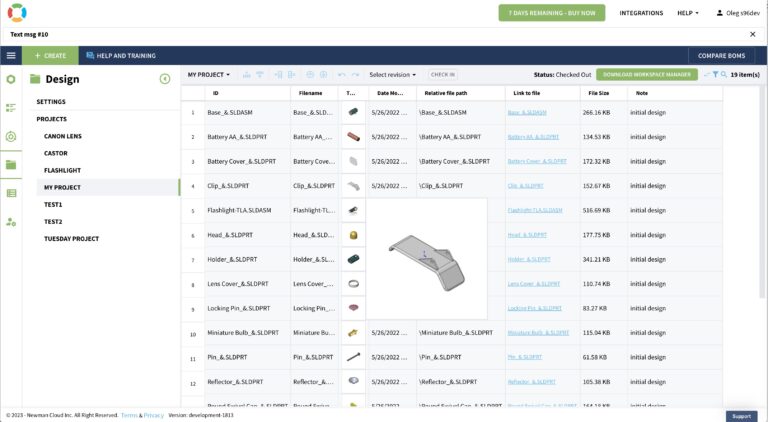
Below is an example of the OpenBOM dashboard
Below is an example of a BOM presented in a multi-level grid with custom attributes.
Navigation
OpenBOM offers visual graph navigation capabilities such as a hierarchical tree or property graph navigation to visualize the connectivity between data elements [ Note: graph navigation nodes use first 4 properties from “Dashboard” display]

More flexible object-link navigation capabilities allow you to drill down into relationships between objects and navigate between complex elements of the information (design, engineering, purchasing, etc.)

Configuration and Customization
To support configuration and customization, OpenBOM provides a configurable user-defined view to present data in a variety of forms (e.g. Engineering, Manufacturing, Contractor, etc.)
Collaboration and Communication
To support collaboration and efficient communication, OpenBOM allows simultaneous editing capabilities by allowing multiple users to edit the same view of data shared and edited at the same time.

The multi-tenant capabilities of OpenBOM enable users, teams, and companies to isolate their data while also sharing it in real time. This means you can share and edit data simultaneously, without the need to export it to an external file when collaborating with contractors or suppliers.
Change and Lifecycle Management
Tracking the lifecycle of products and managing changes is made simple with OpenBOM. OpenBOM blends PDM, PLM, and ERP functions, allowing seamless management of product information with customization and integration capabilities.
Change management is the process of controlling changes to product information during the various stages of product development, manufacturing, and support. It also includes the organization of change requests, the organization of change approval processes, traceability, and communication.
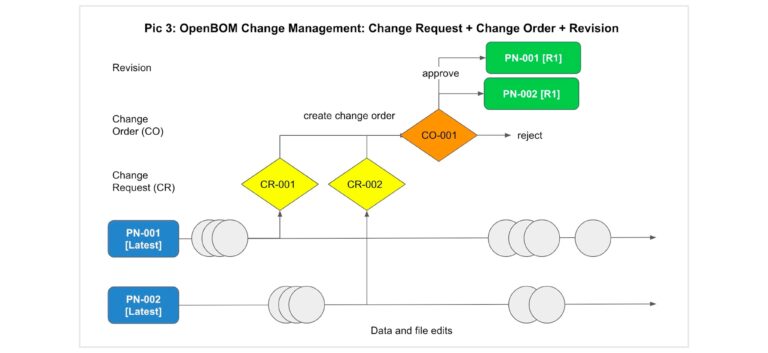
OpenBOM lets you easily view change history, revisions, change reports, change requests, and approvals. Similar to GitHub and modern cloud CAD systems, OpenBOM allows the management of a baseline (latest state) of changes and captures immutable snapshots (to manage revisions). Whenever data is changed in catalogs, BOMs, orders, etc. the changes are captured and preserved in the OpenBOM database.
OpenBOM also provides a uniquely flexible and scalable approach to data organization to manage the product lifecycle:
Product record and a single version of the truth
OpenBOM creates unique data records for all items and corresponding information (e.g. part numbers, descriptions, revisions, cost, etc.) In addition, the data model is flexible so BOMs can be extended with usage information at any time.
Automatic BOM creation and updates from any CAD systems
OpenBOM eliminates manual counting. A single click generates and updates BOMs, with easy tracking of changes and creation of revisions.
Automatic quantity calculation, formulas, and custom rollups
You can combine multiple assemblies into a single multi-level BOM and automatically calculate everything you need for planning and purchasing.
Instant data sharing mechanism or automatic role-based sharing using team views
OpenBOM enables instant sharing, real-time collaboration and simultaneous sharing capabilities, ensuring up-to-date information for everyone.
Out-of-the-box purchasing planning process
OpenBOM creates an Order BOM (planning BOM), which can scale the quantity to the level of the order, keep track of stock levels (quantity on hand), and automate the process of purchase order creation.
Integrations
OpenBOM supports a wide range of integrations with CAD, PDM, PLM, ERP, CRM, Content Management, cloud file storage systems, and even Excel, further enhancing its functionality and scope. With seamless integration into systems, data transfer becomes hassle-free, eliminating the risk of manual errors and improving productivity.
CAD Tools
OpenBOM supports integrations with popular CAD tools such as Solidworks, PTC Onshape, Autodesk Inventor, and Autodesk Fusion 360, to name a few.
Engineering and Enterprise Systems
OpenBOM provides out-of-the-box and custom integrations for engineering and enterprise systems. These integrations enable automatic extraction and updating of BOM data directly from the source systems or files.E
ERP Systems
OpenBOM can easily integrate with ERP systems like SAP, Oracle, or Microsoft Dynamics to streamline the transfer of BOM data into production workflows.
Custom Integrations
Through its REST API, OpenBOM also provides the capability to build custom integrations, further enhancing its interoperability.
